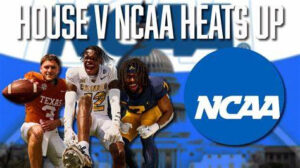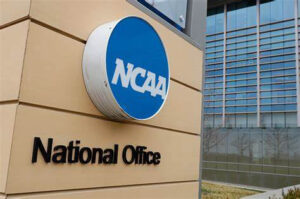This Case Could Break College Sports Wide Open – House v. NCAA and the Future of Revenue Sharing – Ludwig P. Gaines, J.D., President, The 360 NIL Group LLC.
 The world of college athletics is once again at a major crossroads. On the heels of the NIL (Name, Image, and Likeness) revolution that allows athletes to earn money from endorsements, another seismic shift looms: revenue sharing. The upcoming House v. NCAA settlement approval hearing could fundamentally change how college sports operate — financially, legally, and culturally.
The world of college athletics is once again at a major crossroads. On the heels of the NIL (Name, Image, and Likeness) revolution that allows athletes to earn money from endorsements, another seismic shift looms: revenue sharing. The upcoming House v. NCAA settlement approval hearing could fundamentally change how college sports operate — financially, legally, and culturally.
Here’s what you need to know.
A Quick Recap: What Is House v. NCAA?
House v. NCAA is a class-action lawsuit filed on behalf of college athletes arguing that the NCAA and major conferences unlawfully restricted their ability to earn a fair share of the revenues generated by their athletic performances. It follows the momentum of Alston v. NCAA (2021), where the U.S. Supreme Court ruled that the NCAA violated antitrust laws by limiting education-related benefits.
Now, with House, athletes are pushing even further — demanding direct compensation tied to the billions generated by college sports, particularly football and men’s and women’s basketball.
Rather than risk a costly trial (and likely another loss), the NCAA and major conferences have agreed to a proposed settlement, the details of which are scheduled for a critical approval hearing soon.
What’s in the Proposed Settlement?

The proposed settlement — valued at over $2.7 billion — would create a revenue-sharing model allowing athletes to receive direct payments from their schools, starting in 2025.
Key points include:
- Revenue Sharing: Schools could share up to roughly $20 million annually with athletes.
- Backpay: The settlement would include retroactive payments to former athletes who missed out on NIL opportunities before the rules changed.
- Roster Management: Schools will need to decide how to distribute funds across different sports and rosters, raising tough questions about equity between revenue-generating and non-revenue sports.
- NIL Integration: Schools will likely look for ways to balance traditional NIL deals with new direct payments.
This could mark the beginning of a new “professionalized” era of college athletics — while still technically maintaining athletes’ “student” status.
What’s at Stake for Schools and Athletes?

The stakes could not be higher.
- For Schools: They must reconfigure budgets, possibly cut sports, and rethink how they manage scholarships and recruiting. Some mid-major programs may struggle to keep up with revenue-sharing demands.
- For Athletes: A successful settlement could mean a guaranteed stream of income beyond just NIL deals — a win for athletes across sports, genders, and visibility levels.
- For the NCAA: It’s yet another blow to the “amateurism” model the organization clung to for decades. The NCAA’s role as the central authority of college sports is weakening dramatically.
And that’s before considering the looming threat of federal intervention: some policymakers are pushing for new laws to regulate college sports compensation nationally.
Implications for HBCUs
 Historically Black Colleges and Universities (HBCUs) face both promise and pressure under the new revenue-sharing model. The settlement could help HBCUs stay competitive by offering athletes new financial incentives. However, many HBCUs worry about the financial strain: they’re responsible for a share of the $2.8 billion settlement and future payouts, despite generally having far smaller athletic budgets.
Historically Black Colleges and Universities (HBCUs) face both promise and pressure under the new revenue-sharing model. The settlement could help HBCUs stay competitive by offering athletes new financial incentives. However, many HBCUs worry about the financial strain: they’re responsible for a share of the $2.8 billion settlement and future payouts, despite generally having far smaller athletic budgets.
Revenue sharing could force some tough choices — possibly cutting support for non-revenue sports or challenging schools’ ability to meet Title IX requirements. While athletes at HBCUs stand to gain financially, their institutions must walk a fine line to avoid jeopardizing overall athletic and academic sustainability.
Implications for Liberal Arts Colleges
Small liberal arts colleges, known for their academic focus and modest sports budgets, are also facing tough decisions. Some, like Davidson College, are opting in to revenue-sharing models to remain competitive in attracting top athletes. However, without the major TV contracts that power larger athletic programs, these schools could face serious financial pressure.
While revenue sharing could enhance recruiting and help retain talent, it might also require diverting funds from other athletic or academic programs. Some academically-focused institutions, like Ivy League schools, are choosing to reject revenue sharing altogether — a decision that may accelerate the migration of elite athletes to schools willing to pay.
Who Could Benefit: A Real-World Snapshot
Consider a starting offensive lineman at a mid-major Division I football program. While he plays a crucial role protecting the quarterback and driving his team’s success, his position doesn’t typically attract big-name NIL deals or major media attention. Under the proposed House v.
NCAA settlement, athletes like him could finally receive direct revenue-sharing payments — potentially tens of thousands of dollars annually — simply for their contributions on the field. In addition, he may be eligible for backpay for seasons played under the NCAA’s former restrictions, offering overdue recognition for his role in generating millions for his school and conference.
Now imagine a standout women’s volleyball player competing at the highest level of college athletics. Although her team may not bring in football-sized television revenues, her performances, championships, and visibility contribute significantly to her school’s athletic brand. Through the new model, she could receive both direct compensation and retroactive payments, affirming that revenue sharing isn’t just about football and men’s basketball — it’s about valuing the broad ecosystem of athletes who fuel college sports’ success.
The House v. NCAA settlement isn’t just a win for headline-making stars. It has the potential to uplift a wide range of student-athletes — across genders, sports, and schools — ensuring their work, talent, and sacrifices are finally acknowledged and compensated.
Final Thoughts
The House v. NCAA settlement hearing isn’t just another court date — it’s a pivotal moment that could finally tip college sports from the old “amateur” model into a hybrid version of professional athletics.
If you’re a school leader, coach, athletic director, or student-athlete navigating these changes, staying informed and strategic is critical. For real-time insights and expert advice on how revenue sharing, NIL, and the evolving landscape impact your program, contact the 360 NIL Group.
We’re here to help you succeed in this new era of college athletics.
—
About the 360 NIL Group
360 NIL Group is a premier consulting and education firm helping colleges, universities, athletic departments, and student-athletes navigate the evolving world of NIL, revenue sharing, and college sports business strategy. We offer customized solutions in compliance, brand development, wellness, and financial literacy to ensure institutions and athletes thrive in the modern college athletics landscape. Whether you’re building your NIL infrastructure, preparing for revenue sharing, or developing strategies to stay competitive, 360 NIL Group provides the real-time expertise you need to succeed.

